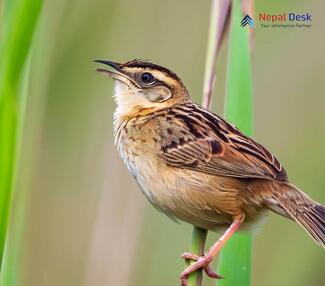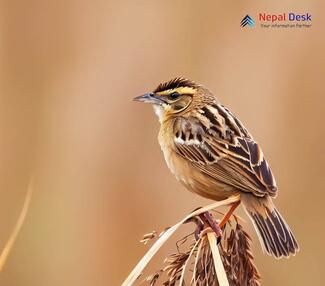The Striated Grassbird (Megalurus palustris) is an intriguing songbird species belonging to the family Locustellidae. Its fascinating appearance, distinctive nesting habits, and unique call have captured the attention of bird enthusiasts and ornithologists alike. This incredible bird is known to inhabit grasslands and wetlands throughout Asia, and has a significant presence in Nepal. In this article, we'll delve into the fascinating world of the Striated Grassbird, exploring its characteristics, habitat, behavior, and connection with Nepal.
Characteristics of the Striated Grassbird
The Striated Grassbird is an elusive medium-sized bird with a grayish-brown head and upperparts adorned with dark streaks. Its tail feathers are long and graduated, which is a characteristic feature of this species. The bird's underparts are paler with fine dark streaks on the breast while the throat appears white. Measuring about 18-23 cm in length, these birds have short wings and long legs, which aid them in navigating their preferred habitats.
Habitat and Distribution
Preferring tall grasses or reeds near water bodies such as marshes and swamps, the Striated Grassbird can be found throughout Southeast Asia. Their geographical range stretches from India to the Philippines and includes countries like Bangladesh, Cambodia, Bhutan, Myanmar, Thailand, Vietnam, and Nepal. In Nepal, particularly in the southern Terai region where wetlands are abundant, this remarkable species can be easily observed.
Behavior & Diet
The Striated Grassbird is principally insectivorous; it feeds on insects like grasshoppers, beetles, caterpillars, and spiders as well on some seeds. They forage for food by carefully moving about in their dense habitat rarely revealing themselves in open spaces. Acrobatic in nature while capturing their prey; they adeptly navigate through the tall grasses.
One interesting aspect of their behavior is their unique call, a series of high-pitched, chirruping notes followed by a distinctive buzz. This loud and melodious song can be heard during the breeding season when the bird advertises its presence to potential mates.
Nesting and Breeding
During the breeding season, from April to September, Striated Grassbirds build their nests in tall grasses or reeds - typically above water, which provides safety from predators such as snakes. The female constructs a deep cup-shaped nest using grass blades and plant stems, which is well-hidden among the vegetation. She then lays 2-4 eggs, which are incubated for about 12-13 days. Both parents share the responsibility of feeding and caring for their young until they are ready to fledge after 11-14 days.
Conservation Status
The Striated Grassbird is currently listed as "Least Concern" on the IUCN Red List due to its broad distribution range. However, as with many wetland-dependent species, the destruction and degradation of its natural habitat pose a genuine threat to its population. Hence, promoting wetland conservation efforts in Nepal and across its primary range would be instrumental in ensuring the long-term survival of this fascinating species.
In conclusion, the Striated Grassbird is a captivating bird that thrives in unique habitats like those found in Nepal's Terai region. Its striking appearance and melodious call add to the rich biodiversity of these ecosystems. By supporting wetland conservation initiatives, we can help preserve not only this enchanting species but also countless other plant and animal life that calls these delicate habitats home.




